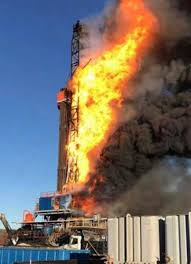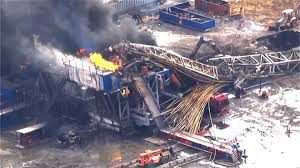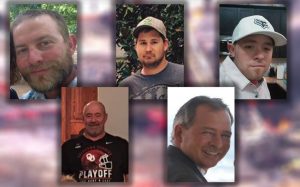
The final report into the January 2018 well blowout and fire that killed five workers on a gas rig near Quinton in Southeast Oklahoma was released by the U.S. Chemical Safety Board on Wednesday.
The Board laid blame on what it called “significant lapses in good safety practices” at the site, stating there was also a lack of planning, training, equipment, skills and procedures.
As a result of the investigation, the Board learned there is a lack of regulations governing onshore drilling safety as well as shortcomings in safety management systems and industry standards used by the industry.
The report called on regulators, industry groups, the state of Oklahoma and companies to address such gaps.

The cause of the blowout and fire that literally melted the rig was determined to be the failure of two preventive barriers intended to be in place to stop a blowout. Those were the primary barrier—hydrostatic pressure in the well produced by drilling mud—and the secondary barrier–human detection of gas flowing into or expanding in the well and activation of the rig’s blowout prevent.
The report explained that unplanned underbalanced drilling and tripping operations allowed a large quantity of gas to enter the well and safety-critical operations called “flow checks” used to determine if gas is in the well were not performed.
“For over 14 hours, there was a dangerous condition building at this well,” said Kristen Kulinowski, CSB Interim Executive. “The lack of effective safety management at this well resulted in a needless catastrophe.”
The CSB also found that the drilling contractor failed to maintain an effective alarm system.
“Likely due to excessive “nuisance” or unnecessary alarms, the entire alarm system was disabled by rig personnel,” stated the Board announcement. “Ultimately, the lack of critical alarms contributed to workers being unaware that flammable gas was entering the well during operations before the incident.”
Three workers were in the driller’s cabin at the time of the blowout. Two others were on the rig floor and ran into the cabin during the blowout and fire.
“When the blowout mud and gas ignited, it created a massive fire on the rig floor. All five of the workers inside the driller’s cabin were effectively trapped because fire blocked the driller’s cabin’ two exist doors,” said Investigator Lauren Grim. “Our investigation found that there is no guidance to ensure that an emergency evacuation option is present onboard these rigs or can protect workers in the driller’s cabin from fire hazards.”
The Chemical Safety Board learned as a result of this tragedy that there are no regulations specifically developed for onshore oil and gas well drilling. Because oil and gas well drilling is exempted from the Occupational Safety and Health Administration’s Process Safety Management standard which governs safety for chemical processing facilities, OSHA has been using a general duty clause. But it fails to address what the board called “unique safety hazards” associated with drilling for oil and gas.
The CSB urges OSHA to develop effective oversight that addresses the hazards unique to the onshore drilling industry, stated the announcement. The Board also called on the American Petroleum Institute to address design improvements needed to protect driller’s cabin occupants from blowout and fire hazards.
“As onshore oil and gas extraction grows, it is imperative that the industry is using proven and reliable safety standards and practices,” said CSB Executive Dr. Kristen Kulinowski. “If some of these safety practices had been in place, this tragedy could have been averted.”
The deadly incident happened on the Pryor Trust 0718 drilling pad where the second of two wells was being drilled on Jan. 22, 2018. Well # 1H-9 was the second well being drilled when the fire and blast occurred.
The leader holder was Red Mountain Energy while Red Mountain Operating was the operator of the well. Patterson-UTI Drilling Co. was the drilling contractor hired by RMO. The Patterson rig 219 had drilled both wells.
Authorities say there were 22 workers on the well site, which was being drilled by Houston-based Patterson-UTI Energy, at the time of the explosion.

The victims were: 35-year-old Josh Ray, 29-year-old Matthew Smith, 26-year-old Cody Risk, 60-year-old Parker Waldridge and 55-year-old Roger Cunningham.
Nearly six months after the five were killed, OSHA cited Patterson-UTI Drilling, Crescent Consulting LLC and Skyline Directional Drilling LLC for exposing workers to explosion hazards.
OSHA also cited Patterson-UTI and Crescent Consulting for failing to maintain proper controls while drilling a well, failing to inspect slow descent devices and implement emergency response plans.
All three companies were cited for failing to ensure that heat lamps in use were approved for hazardous locations.
“These employers failed to properly control hazards involved in oil and gas extraction activities, and the result was tragic,” said OSHA Oklahoma City Area Office Director David Bates. “Employers are required to monitor their operations to ensure workplace health and safety procedures are adequate and effective.”
Click here to read the 158-page report.
file:///C:/Users/User/Downloads/Pryor_Trust_Report_FINAL_FOR_PUBLICATION%20(1).pdf





